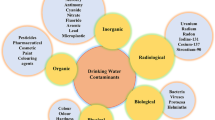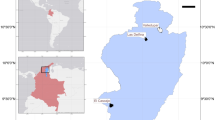Abstract
The paper presents new conceptual approaches to establishing indices for the quality of physiologically wholesome drinking water for the population based on the analysis of the composition of surface and underground sources of water supply in Ukraine. We have proposed ecological regulations for the quality of Ukraine’s surface waters as a basis for the choice of quality values of these indices. These regulations provide effectively for the absence of anthropogenic contamination of natural sources of water supply. We have also considered present-day approaches to regulating maximum admissible concentrations (MAC) of drinking water impurities during its conditioning at the stations of centralized water supply. We have provided qualitative MAC values of water impurities, which may be recommended taking into account technological and economic possibilities.
Similar content being viewed by others
References
Strikalenko, G.V., Voda i Vodoochistni Tekhnologii, 2006, no. 2(18), pp, 34–38.
Erisma, F.F., Zdorov’e, 1884, pp. 22–24.
Russian Federation, The Federal Law “On Special Technical Regulation for Requirements for Sanitary-Epidemiological Safety to Water Intended for Human Consumption and Drinking Water Supply” (draft), Nauchno-Inform. Sb., 2004, vol. 19, no. 1, p. 27.
Guidelines for Drinking Water Quality Control, Geneva: WHO, 1994.
Wadha, S.G., Khaled, G.H., and Edberg, S.C., Crit. Rev. Microbiol., 2002, vol. 28, no. 3, pp. 249–279.
Pathological Basis of Disease (5th Edition), Cotran, R.S., Kumar, V.I., Eds., Philadelphia: Saunders W.B., 1994.
Principles and Practice of Infectious Diseases (5th Edition), Mandell, G.L., Douglas, J.E., and Benett, R.I., Eds., Philadelphia: Churchill Livingston, 2000.
Ducan, H.E. and Edberg, S.C., Crit. Rev. Microbial., 1995, no. 21, pp. 85–95.
Edberg, S.C., Gallo, P.I., and Kontnick, C.I., Micro. Ecol. Health Dis., 1996, no. 9, pp. 67–72.
Eberg, S.C., Kops, S., Kontnick, C., and Escarzaga, M., J.Appl. Microbial., 1997, vol. 82, pp. 455–481.
Reasoner, D.J., Drinking Water Microbiology, New York: Springer-Verlag, 1990.
Guidelines for Drinking Water Quality. Recommendations, Geneva: World Health Organization, vol. 1. 2004.
Water Framework Guidelines. Joint Strategy of Introduction. Working Group 2A. Ecological State (ECOSTAT) in General Approach to Classification of Ecological State and Ecological Potential: Rome, 24–25 November, 2003.
Romanenko. V.O., Zhukinskii, V.M., Oksiyuk, O.P., et al., Metodyka ekolohichnoi otsinky yakosti poverkhnevykh vod za vidpovidnymy kryteriyamy (Technique of Ecological Assessment of Drinking Water Quality by Relevant Criteria), Kiev: SYPVOP-T, 1998.
Ukraine’s Water Code, Vidomosti Verkhovnoi Rady Ukrainy, no. 4, pp. 3–21.
Metodyky stanovelnnya i vykorystannya ekologichnykh normatyviv yakosti poverkhnevykh vod sushi ta estuariiv Ukrainy (Techniques for Setting and Use of Ecological Standards for Surface Water Quality and Land and Estuaries of Ukraine), Kiev: Minekoresursy Ukrainy, 2001.
Chernyavskaya, A.P., Hydrology, Hydrochemistry, and Hydroecology, 2001, vol. 1, pp. 702–712.
Oksiyuk, O.P. and Zhukiskii, V.M., Hidrobiol. Zhurn., 1999, vol. 35, no. 6, pp. 16–21.
Yatsik, A.V., Chernyavska, A.P., and Yezdovets’ka, I.S., Retrospektyvna otsinka vstanovlennya i vikorystannya ekologichnykh normatyviv yakosti vody dla verkhiv’ya Dnistra (Retrospective Assessment of Setting and Use of Ecological Standards for Water Quality for the Upper Reaches of the River Dnistr, No. 01 98V003473, Kiev: UNDIVEP, 2001.
Yatsik, A.V., Chernyavska, A.P., and Yezdovets’ka, I.S., Retrospektyvna otsinka vstanovlennya i vikorystannya ekologichnykh normatyviv yakosti vody dla poverkhnevykh vod Volyns’koi oblasti (Retrospective Assessment of Setting and Use of Ecological Standards for Water Quality for Surface Waters of the Volyn’ Region), No. 01 02V005904, Kiev: UNDIVEP, 2002/2003.
Byuvety Kieva. Yakist artezianskoi vody (Kiev’s Artesian Wells. Quality of Artesian Water), Goncharuk, V.V., Ed., Kiev: Geoprinkt, 2003.
Gidrokhimecheskii atlas SSSR (Hydrochemical Atlas of the USSR), Moscow: Glavnoye Upravlenie Geodezii i Kartographii pri Sovmine SSSR, 1990.
Results of the International Complex Expedition “The Blue Danube-90”, Vodn. Resursy, 1991, vol. 20, no. 4, pp. 405–552.
Shevtsova, L.V., Aliev, K.A., Kuz’ka, O.A., et al., Ekologicheskoe sostoyanie reki Dnestr (Ecological State of the River Dnestr), Kiev: Izdatelstvo Oriyany, 1998.
Sinclair, M. and Schlosser, O., Water 21. February, 2007, pp. 18–19.
Rosenlund, M, and Berglind, N., Epidemiology, 2005, vol. 16, no. 4, pp. 570–576.
Mons, M., VanDuk, H., Gatel, D., Hesse, S., and My-Linh Nguyen, Water 21. February. 2007, pp. 19–21.
International Agency for Research on Cancer. Beryllium, Cadmium, Mercury, and Exposures in the Glass Manufacturing Industry. IARC Monographs on the Evaluation for Carcinogenic Risks to Humans, Lyon: IARC, 1993, vol. 58, pp. 41–117.
Vaessent Hubert A.M.G. and Szteke, B., Food Additives and Contaminants, 2000, vol. 17, no. 2, pp. 149–159.
Anderson, A., Clean Water Report, 2004.
Fewtrell, L., Kay, D., and Macgill, S., J. of Environ, Health Res., 2001, vol. 11, pp. 161–167.
Derzhavni sanitarni pravyla i normy SanPin “Voda pytna, Gigienichni vymohy do yakosti vody tsentralizovanoho hospodars’ko-pytnoho vodopostachannya (State Sanitary Rules and Standards SanPin “Drinking Water, Hygienic Requirements to Water Quality of the Centralized Household-Drinking Water Supply”, no. 383 of December 23, 1996.
American Public Health Association News, J. of Public Health, 2001, vol. 93, no. 3, pp. 499–500.
Goncharuk, V.V., Rudenko, A.V., Koval’, E.Z., and Savluk, O.S., Khimiya i Tekhnologiya Vody, 2004, vol. 26, no. 2, pp. 120–144.
Gang, D., Clevenger, T.E., and Banerji, S.K., J. Haz. Mat., 2003, vol. A96, pp. 1–12.
The Guidelines of the European Union Council 98/83/EC for Water Quality Intended for Consumption by Man. Official J. of the Eur. Commun., 1998, pp. 2–5.
Standards and Strategies in the European Union to Control Trihalomethanes (THMS) in Drinking Water, Joint Research Centre (JRC-Ispra), 1997.
Exposure of the European Population to Trihalomethanes (THMS) in Drinking Water, EC Joint Research Centre (JRC-Ispra), 1997.
Meeting Strict DBP Standards—The View of the European Water Industry, Dr. Breach, R.A., Head of Quality and Environmental Services. Severn Trent Water, Chairman, EUREAY Commission 1, 2006, pp. 140–145.
Charrois, J.M.A., Graham, D., Hrudey, S.A., and Froese, K.L., J. Toxicol. and Environ. Health, Pt. A., 2004, vol. 67, pp. 1997–1803.
Swietlik, J., Raczyk-Stanislavik, U., Bilozor, S., et al., Water Res., 2002, vol. 36, no. 9, pp. 2328–2336.
Seietlik, J., Raczyk-Stanislavik, U., Bilozor, S., et al., ibid., 2003, vol. 37, no. 19, pp. 4693–4702.
Collivignarelli, C., Sorlini, S., and Belluanti, M., Ingeneria Ambientale, 2002, vol. 31, no. 5, pp. 265–271.
Roccaro, P., Mancini, G., and Vagliasindi, F.G.A., Desalination, 2005, vol. 176. pp. 1–11.
Linden, K.G., Shin, G.A., Faubert, G., et al., Environ. Sci. and Technol., 2002, vol. 36, no. 11, pp. 251–2522.
Shin, G., Linden, K., Arrowood, M., and Sobsey, M., Appl, Environ. Microbiol., 2001, vol. 67, no, 7, pp. 3029–3032.
Legrini, O., Oliveros, E., and Braun, A., Chem. Rev., 1993, vol. 93, no. 2, pp. 671–698.
Brass, H.J., Water, Air, and Soil Pollut., 2000, vol. 123, pp. 1–9.
Caro, J., Serrano, A., and Gallego, M., J. Chromatogr., A., 2000, vol. 11, no. 38, pp 244–250.
DBP Standards and Regulation: the UK and European Situation, Owen Hyde’s, Deputy Chief Inspector, Drinking Water Inspectorate, Disinfection By-products in Drinking Water: Current Issues: 1999.
Doilido, Q., Zbiec, E., and Swietlik, J. Water Res., 1999, vol. 33, pp. 3111–3118.
U.S. Environmental Protection Agency, Disinfectants and Disinfection By-Products; Final Rule. 40 CFR Pts. 9, 141, and 142, National Primary Drinking Water Regulations, Fed. Reg. 63, 1998, pp. 69389–69476.
Goncharuk, V.V., Klimenko. N.A., Savchina, L.A., Vrubel’, T.L., and Kozyatnik, I.P., Khimiya i Tekhnologiya Vody, 2006, vol. 28, no. 1, pp. 3–95.
El-Dib, M.A. and Ali, R.K.A., Water Res., 1995, vol. 29. no. 9. pp. 375–378.
Lin, T-F. and Hoang, S.W., Sci. Total Environ., 2000, vol. 246, pp. 41–49.
Boccellia, D.L., Trybyb, M.E., Uberg, J.G., and Summersend, K.S., Water Res., 2003, vol. 37, no. 3, pp. 2654–2666.
Gang, D., Clevenger, T.E., and Banerji, S.K., J. Haz. Mat., 2003, vol. A96, pp. 1–12.
Abdulahha M, Pauzi, Yewa, C.H., and Ramlib, M.S., Water Res., 2003, vol. 37, no. 2, pp. 46–4644.
Abd El-Shafy, M. and Grunwald, A., ibid., 2000, vol. 43, no. 13, pp. 3453–3459.
Fomin, G.S., Voda. Kontrol’khimicheskoi, bakterialnoi i radiatsionnoi bezopasnosti po mezhndunarodnym standartam (Water. Control of Chemical, Bacterial, and Radiation Safety by International Standards), Encyclopedia Reference Book: Moscow, 2000.
Cortvriend, J. and Hulsmann, A., Water 21. August, 2001, pp. 17–19.
Sauvant, M-P. and Pepin, D., Food and Chem. Toxicol., 2000, vol. 40, pp. 1311–1325.
Yang, C.Y., Stroke, 1998, vol. 29, pp. 411–414.
Water Global News Digest, 23 January 2007.-http:www.iwapublishing.com/templte.cfm?name=gnd23jan07.
Water Global News Digest, 6 February 2007.-http:www.iwapublishing.com/templte.cfm?name=gnd06feb07.
Guerrant, R.L., Emerging Infectious Diseases, 1997, vol. 3, no. 1, pp. 211–224.
Ekologocheskie aspekty sovremennykh tekhnologii okhrany vodnoi sredy (Ecological Aspects of Modern Technologies of Water Medium Protection), Goncharuk, V.V., Ed., Kiev: Nauk. Dumka. 2003.
Balls, M., Toxicol. In Vitro, 2004, vol. 18, pp. 165–170.
Pleteneva, T.V., Solomatin, E.M., Syroezhkin, A.V., et al., Toksikologicheskaya khimiya (Toxicological Chemistry), Moscow: GEOTAR-Media, 2005.
Sundstrom, L., Morrison, B., Brandley, M., and Pringle, A., Drug Discovery Today, 2005, vol. 10, no. 14, pp. 993–1000.
Ferro, M. and Doyle, A., Cell. Biol. And Toxicol., 2001, vol. 17, pp. 205–212.
Ilyin, S., Belkowski, S., and Plata-Salamna, C., Trends in Biotechnol., 2004, vol. 22, no. 8, pp. 411–416.
Arkhipchuk, V.V. and Goncharuk, V.V., Khimiya i Tekhnologiya Vody, 2004, vol. 26, no. 8, pp. 485–525.
Freshney, I., Cell. Biol. And Toxicol., 2001, vol. 17, pp. 213–230.
Gulden, M., Dierickx, P., and Seibert, H., Toxicol. In Vitro, 2006, vol. 20, no. 7, pp. 114–1124.
Author information
Authors and Affiliations
Additional information
Original Russian Text © V.V. Goncharuk, 2007, published in Khimiya i Tekhnologiya Vody, 2007, Vol. 29, No. 4, pp. 297–356.
About this article
Cite this article
Goncharuk, V.V. The concept of choosing a list of indices and their regulatory values for determination of hygienic requirements and control over the drinking water quality in Ukraine. J. Water Chem. Technol. 29, 163–196 (2007). https://doi.org/10.3103/S1063455X07040017
Received:
Issue Date:
DOI: https://doi.org/10.3103/S1063455X07040017




